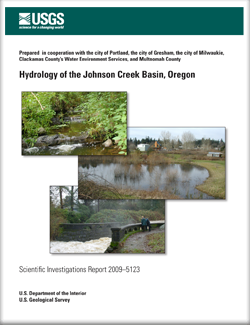 Abstract
Abstract
The Johnson Creek basin is an important resource in the Portland, Oregon, metropolitan area. Johnson Creek forms a wildlife and recreational corridor through densely populated areas of the cities of Milwaukie, Portland, and Gresham, and rural and agricultural areas of Multnomah and Clackamas Counties. The basin has changed as a result of agricultural and urban development, stream channelization, and construction of roads, drains, and other features characteristic of human occupation. Flooding of Johnson Creek is a concern for the public and for water management officials. The interaction of the groundwater and surface-water systems in the Johnson Creek basin also is important. The occurrence of flooding from high groundwater discharge and from a rising water table prompted this study. As the Portland metropolitan area continues to grow, human-induced effects on streams in the Johnson Creek basin will continue. This report provides information on the groundwater and surface-water systems over a range of hydrologic conditions, as well as the interaction these of systems, and will aid in management of water resources in the area.
High and low flows of Crystal Springs Creek, a tributary to Johnson Creek, were explained by streamflow and groundwater levels collected for this study, and results from previous studies. High flows of Crystal Springs Creek began in summer 1996, and did not diminish until 2000. Low streamflow of Crystal Springs Creek occurred in 2005. Flow of Crystal Springs Creek related to water-level fluctuations in a nearby well, enabling prediction of streamflow based on groundwater level.
Holgate Lake is an ephemeral lake in Southeast Portland that has inundated residential areas several times since the 1940s. The water-surface elevation of the lake closely tracked the elevation of the water table in a nearby well, indicating that the occurrence of the lake is an expression of the water table. Antecedent conditions of the groundwater level and autumn and winter precipitation totals were used to anticipate flooding of Holgate Lake.
Several factors affect annual mean flow of Johnson Creek. More precipitation falls in the southeastern area of the basin because of the topographic setting. Runoff from much of the northern and western areas of the basin does not flow into Johnson Creek due to permeable deposits, interception by combined sewer systems, and by groundwater flow away from Johnson Creek. Inflow from Crystal Springs Creek accounts for one-half of the increase in streamflow of Johnson Creek between the Sycamore and Milwaukie sites.
Low flows of Johnson Creek vary as a result of fluctuations in groundwater discharge to the creek, although past water uses may have decreased flows. The groundwater contributions to streamflow upstream of river mile (RM) 5.5 are small compared to contributions downstream of this point. Comparison of flows to a nearby basin indicates that diversions of surface water may have resulted in a 50 percent decrease in low flows from about 1955 to 1977.
Runoff from the drainage basin area upstream of the Johnson Creek at Sycamore site contributes more to peak streamflow and peak volume than the drainage basin area between the Sycamore and Milwaukie sites. The average increase in annual peak streamflow and annual peak volume between the two sites was 11 and 24 percent, respectively. Decreased contribution in the lower area of the drainage basin is a result of infiltration, interception by drywell and combined sewer systems, and temporary overbank storage.
Trends in flow typically associated with increasing urban development were absent in Johnson Creek. Annual, low, and high flows showed no trend from 1941 to 2006. Much of the infrastructure that may affect runoff from agricultural, residential, and urban development was in place prior to collection of hydrologic data in the basin. Management of stormwater in the urban areas by routing runoff from impervious surfaces to drywell and combined sewer systems may have affected runoff characteristics.
Understanding the distribution of runoff in the Johnson Creek basin helps protect water quality. Summer temperature of Johnson Creek and tributary streams is affected by groundwater discharge and by exposure of the stream to the surrounding atmosphere. Although groundwater discharge cools the stream in some reaches, other stream reaches with relatively shallow, unshaded ponds show warming. High flow in Johnson Creek may entrain sediment and sediment-borne contaminants. Management of runoff, especially in the eastern area of the basin, will maintain and improve the ecological health of Johnson Creek.